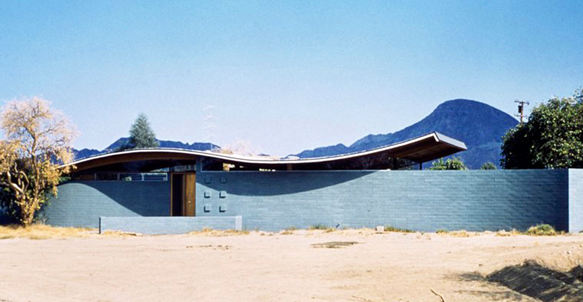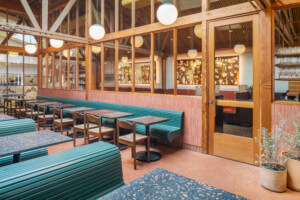The historic Miles C. Bates house in Palm Desert, California was purchased at auction over the weekend by Los Angeles-based Stayner Architects.
The city-owned home had been put on the market earlier this year with the hopes that a buyer interested in preserving and restoring the iconic midcentury structure designed by experimental architect Walter S. White would emerge. To sweeten the deal, Palm Desert officials offered up to $50,000 toward the cost of restoring the abandoned home if the right buyer was found.
At a public auction held in conjunction with Palm Springs Modernism Week Saturday afternoon, city officials finally found that buyer, as the sun-scorched town played host to a dramatic back-and-forth over the home. Ultimately, the father-and-son team at Stayner prevailed over four other bidders for the iconic structure. Bidding on the home started at $50,000 and quickly rose from there in $50,000 intervals until reaching the final sale price of $360,000.

The Desert Sun reports that because the property is city-owned, sale on the home must be completed by June 30. After a city agency approves the deal, the Palm Desert oversight board and the California Department of Finance will issue final approvals for the transaction. Once that happens, the Department of Finance has five days to notify the city that the sale has been approved, after which the property can officially change hands. A timeline for the renovation has not been released.
Christian Stayner, principal at Stayner Architects, said via email, “We are planning to work with the City of Palm Desert to make the restored residence—plus a new accessory structure that we will design and build—available to the public for overnight visits as well as for special events and educational purposes.”
Merilee Colton with the Palm Desert Historical Society said, “We are gratified that the process yielded a qualified buyer interested in preserving the Bates house. Our goal for the house has always been preservation, and many of us hope that the house will become a public space, at least intermittently, so the public can visit this remarkable structure.”

White—who was an admirer of Frank Lloyd Wright and a disciple of Richard Neutra and Albert Frey, among others—designed the house in 1955 as a winter residence for local playboy Miles C. Bates, an artist. The distinctive midcentury home is the product of Bates’s inventive ethos and features a dynamic wave-shaped roof—the home is locally known as the “blue wave house”—that is made from a patented nail-laminated wooden dowel and lumber assembly. The home, with its dramatic roof and a set of garden walls that stretch out into the site, was designed to embrace the craggily, cactus-studded landscape of the area and offers clerestory views toward the Santa Rosa and San Jacinto Mountains National Monument. Today, the structure sits behind a retirement home on a dusty street, its true glory obscured by a series of later additions and a thick coat of beige paint.
The House was listed in the National Register of Historic Places in early 2018.
It now falls to Stayner and his team to rehabilitate the home back to its original configuration and luster as a one-bedroom bachelor pad. Describing what drew him to the Bates house, Stayner said, “The house is a really interesting experiment in terms of its construction and we see it as an important moment in the evolution of the roof as a trope of desert architecture.”











